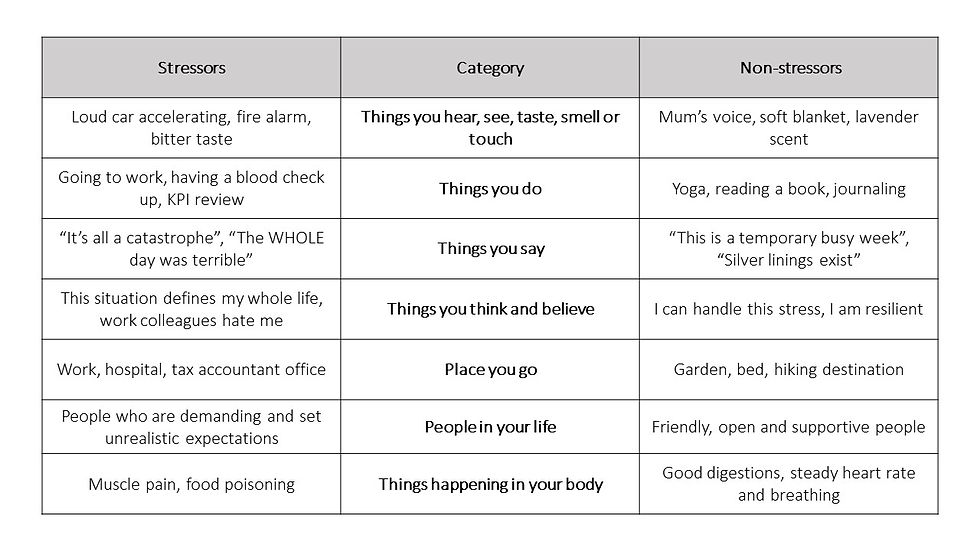Ah! I Am Stressed - Stress and Identifying Stressors
- The Little Physio
- Mar 15, 2019
- 3 min read
Stress is something we experience daily. The stressor can be physical and non-physical elements. How many times have you thought to yourself or heard from others, “Ah, I am so stressed!”? Probably quite a few times. Here's a quick summary of stress, the stress response and seeing what stressors and non-stressors are present in your life.
What is stress?
The definition of stress itself can vary. In the physics realm, stress is defined as an external force acting on a unit area and is often in relation to strain. Physiologically, stress is a resource intensive process that functions to drive the body back to homeostasis, a state of equilibrium within different systems of the body, such as the kidneys, brain and in cardiovascular function. On the other hand, which is what we mostly relate to when we are stressed, is the psychological definition of stress: a state of emotional and mental strain. Whichever definition you associate with, there is a pressure driving an internal stress response.
What is the stress response?
You have probably heard of the fight and flight response and its cousin, the rest and digest response. When the body detects a physical, social or psychological stressor the fight or flight response is activated. This response has evolved in the history of human evolution to save us from a sabre tooth tiger and allow us to pass on our genes to the next generation. The flight or fight response is a part of the sympathetic nervous system (SNS), whilst the rest and digest response is driven by the parasympathetic nervous system (PSNS).
Simplistically, there is a stressor of any nature that is detected by the nervous system and a response is elicited. This process is usually a neural, hormonal and immune response. Due to the nature of different systems of the body being activated, stress can have various impacts on your bodily functions.
How does stress impact the body?
The brain, cardiovascular, digestive and immune system are affected by the stress response.
In the brain, accumulative research shows negative decline in memory, cognition and learning. Associated with these changes is structural degeneration of neurons in the areas linked with memory, cognition and learning.
In the cardiovascular system, stress increases heart rate, blood vessel constriction, blood pressure and oxygen demands for the cardiac muscle. Taken together, this can mediate increase blood lipid, promote blood clotting disorders and atherogenesis, leading to chronic cardiac pathologies.
In the digestive system, stress reduces effective absorption of nutrients, promotes gut permeability (things that are meant to be kept out of the blood are allowed free passage into our bodies) and gut inflammation. Stress can also activate previous gut inflammation episodes.
Finally, in the immune system, hormones are released, such as glucocorticoids/cortisol, which suppress the immune system. Other immune factors are simultaneously released, which promotes inflammation and pain to protect the body from danger. So, it's not surprising when we are stressed or feeling under the pump that we also tend to get a cold or more sore!
How do you experience stress?
It can be challenging to identify specific stressors in our personal and professional lives. A part of managing chronic pain is identifying factors perceived as danger (stressor) and safety (non-stressor) messages to the brain. Using a similar concept (thank-you NoiJam for the inspiration), one can use this for identifying stressors.
The Noi group breaks down items into the following (see table below) and emphasises context is key to whether something is a danger or safety message. So, consider each category and think about what stresses you out and on the flipside, what calms you down, gives you clarity and grounding. Some examples are listed below.

Once you have a list of what some stressors and non-stressors are, it can be useful to look at the non-stressor list and pick something to gravitate towards when experiencing stress. This way you can counteract the stress and inject a bit of balance into your perspective again.
At the end of the day, stress is a natural response within human physiology. Without a stress response, our heart rates, blood pressure and breathing would not be regulated. We would not have the capacity to run with that cute dog, go for that run or hike up that mountain. Too much of it and too little of it raises a challenge for our bodies. Finding your unique ways to manage and reassess the circumstances can help turn a frazzled day into something...more pleasant. As with many aspects in our bodies, it is all about balance. Explore what grounds you, find your pleasant balance.
Interested in what you have read? Stay updated by subscribing - link at bottom of the page.
Further resources
https://www.health.harvard.edu/staying-healthy/understanding-the-stress-response
https://noijam.com/2015/03/12/dim-sims/





亚博体育 亚博体育 亚博体育 亚博体育 开云体育 开云体育 开云体育 开云体育 乐鱼体育 爱游戏体育 华体会体育 华体会体育 欧洲杯下注 欧洲杯下注 欧洲杯下注 欧冠下注 欧洲杯外围 欧洲杯外围 开云体育 开云体育 开云体育 亚博体育 欧洲杯下注 欧洲杯投注 亚博体育 亚博体育 亚博体育 开云体育 英雄联盟下注 LPL下注 LOL下注